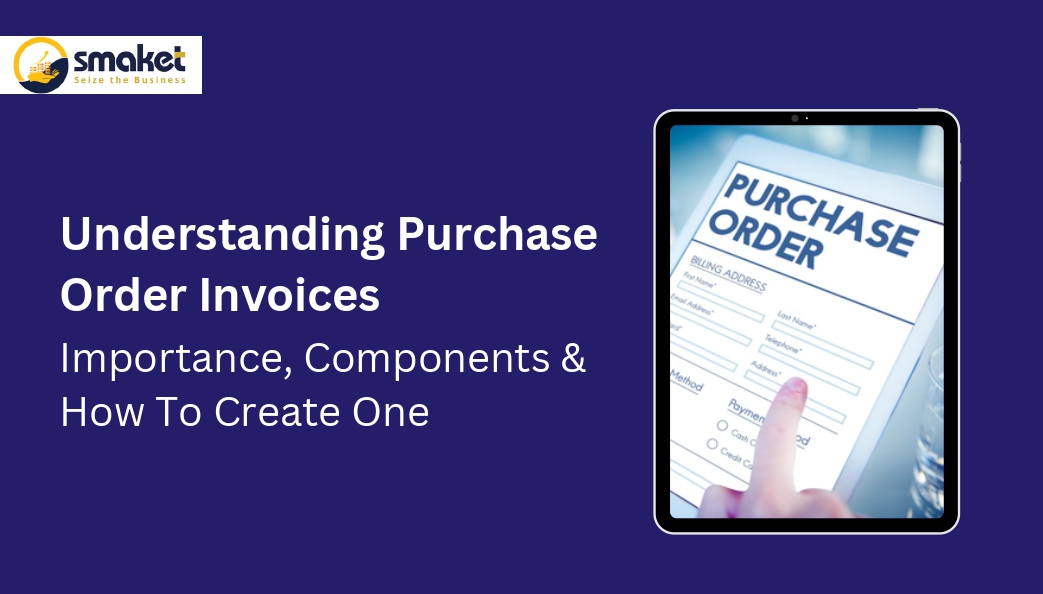A purchase Order Invoice is a legal document that records the purchase of goods or services from a vendor. It outlines the terms and conditions of the purchase, including the quantity, price, and delivery date. It is also a crucial document for any business, as it provides an accurate record of the purchase and helps to ensure that the vendor delivers the goods or services as agreed upon. In this blog, we will discuss the Purchase Order Invoice in detail, including its importance, components, and how to create one.
Importance of Purchase Order Invoice:
A Purchase Order Invoice serves as proof of purchase and establishes a legally binding agreement between the buyer and also the seller. Tracking and reconciling purchases using it helps prevent fraudulent activity and errors. Furthermore, it ensures that the vendor delivers goods or services as per the agreement and allows for prompt resolution of any discrepancies that may arise. The Purchase Order Invoice also serves as a reference for accounting and tax purposes, making it an essential document for any business.
Components of Purchase Order Invoice:
A Purchase Order Invoice typically includes the following components:
Purchase Order Number:
A unique identifier assigned to the purchase order. Seller Information: The vendor information, including their name and address, is also a critical component of a Purchase Order Invoice.
Buyer Information:
The name and address of the buyer.
Date:
The date the Purchase Order Invoice was created.
Item Description:
A description of the goods or services being purchased, including the quantity and price.
Delivery Date:
The date the goods or services are expected to be delivered.
Payment Terms:
The agreed-upon terms of payment, including the due date and method of payment.
Shipping Information:
The shipping address and instructions, if applicable.
Taxes and Fees:
Any taxes or fees associated with the purchase.
Total Amount Due:
The total amount due for the purchase.
How to Create a Purchase Order Invoice:
Creating a Purchase Order Invoice is a straightforward process. Here are the steps to follow:
Determine the need for a Purchase Order Invoice: Before creating a Purchase Order Invoice, determine whether it is necessary. It is recommended to have a Purchase Order Invoice for larger purchases, but if the purchase is small and the vendor is trusted, it may not be required.
Gather all the necessary information, including the vendor’s name and address, the buyer’s name and address, the item description, the delivery date, the payment terms, and the shipping information.
Create the Purchase Order Invoice:
Use a template or create the Purchase Order Invoice from scratch using a word processing or spreadsheet program.
Review and proofread:
Ensure that you include all necessary information in the Purchase Order Invoice and review it for accuracy. Proofreading the document for spelling and grammatical errors is essential to ensure that also the Purchase Order Invoice is accurate and professional.
Send the Purchase Order Invoice:
Send the Purchase Order Invoice to the vendor and retain a copy for accounting and tax purposes.
Conclusion:
A Purchase Order Invoice is a critical document for any business, as it also provides an accurate record of purchases and helps to prevent fraudulent activity and errors. It serves as a legally binding agreement between the buyer and the seller and provides a reference for accounting and tax purposes. Creating a Purchase Order Invoice is also a straightforward process that requires gathering the necessary information, creating the document, and sending it to the vendor. By following these steps, businesses can ensure that they properly track and reconcile their purchases, and that vendors deliver goods and services as agreed upon.
FAQ:
1. What distinguishes a purchase order from an invoice in terms of their purpose and content?
The buyer creates a purchase order to request goods or services from a vendor, while the vendor creates an invoice to bill the buyer for the goods or services provided. A purchase order outlines the terms of the purchase, while an invoice provides the payment details.
2. Do I need a Purchase Order Invoice for every purchase?
Not necessarily. For small purchases from trusted vendors, a Purchase Order Invoice may not be necessary. We also recommend using a Purchase Order Invoice for larger purchases or purchases from new vendors to ensure accuracy and establish a legally binding agreement.
It depends on the vendor’s policy. Usually, you can make changes to an order if the vendor has not yet started fulfilling it. However, if the vendor has already begun the process of fulfilling the order, changes may not be possible.
4. What happens if there is a discrepancy between the Purchase Order Invoice and the goods or services received?
If there is a discrepancy, the buyer should contact the vendor immediately to resolve the issue. Then terms of the purchase are referenced by the Purchase Order Invoice, and any discrepancies should be resolved in accordance with those terms.
5. Can I use a Purchase Order Invoice for services as well as goods?
Yes, you can use a Purchase Order Invoice for both goods and services. The document should include a description of the services being provided, the price, and any other relevant terms and conditions.

